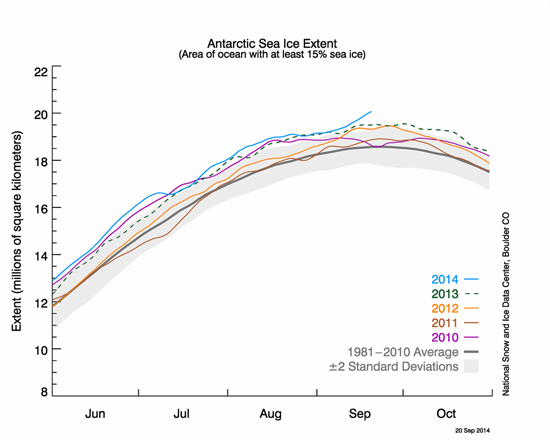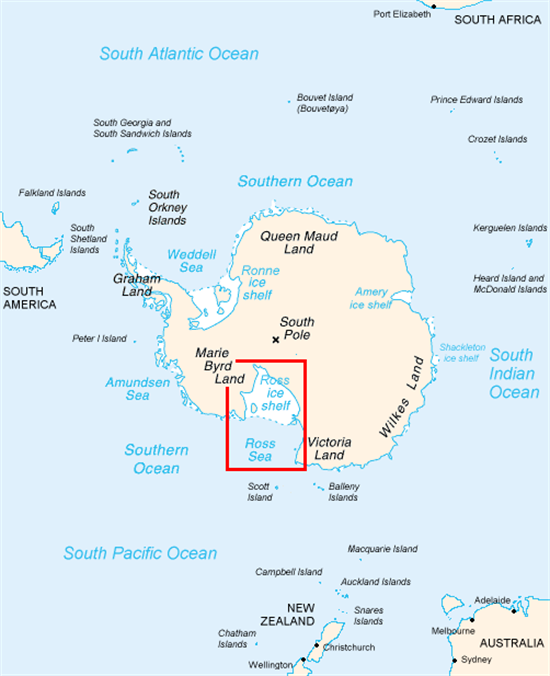Robert McSweeney
23.09.2014 | 4:59pmFor the third year in a row, the extent of sea-ice around Antarctica has surpassed the previous record high. The extent is now the largest since satellite records began in 1979.
But at the North Pole the decline of Arctic sea-ice continues to accelerate. Scientists haven’t yet been able to pin down why the opposite is happening in the Antarctic.
Poles apart
The two poles are very different. The Arctic is a body of water surrounded by land, while the Antarctic is a continent surrounded by water.
It’s around this time of year the Antarctic reaches its winter maximum extent and the Arctic reaches its summer minimum.
The latest figures show that at over 20 million square kilometers (sq km), Antarctic sea-ice currently covers a larger area than at any time over the 35-year satellite record.
The blue line on the figure below shows the sea-ice extent for 2014. Typically the annual peak is in September, but it may grow further before the end of the year.
Antarctic sea-ice extent as of September 20, 2014, along with daily ice extent data for four previous years. Dark grey line shows the 1981 to 2010 average is in dark gray. NSIDC
At the same time as the Antarctic sea-ice is increasing, extent in the Arctic is continuing to decrease. Eight of the lowest measurements of Arctic summer sea-ice extent occurred in the last eight years.
But overall, the Arctic sea-ice loss is over three times greater than Antarctic gain. One study finds that while Southern Hemisphere sea-ice increased by an average of about 15,000 sq km a year between 1979 and 2013, the Northern Hemisphere lost an average of almost 55,000 sq km a year.
Scientific puzzle
Observations show the Southern Ocean that surrounds the Antarctic is warming, and warming more quickly than the other oceans of the world. So what could be happening in the Antarctic? There are several different theories.
One is quite simple: as water melts from beneath ice shelves around Antarctica, it refreezes as sea-ice when it reaches the surface.
Other reasons are more complicated. Wind pattern changes have been linked to the hole in the ozone layer, causing winds around the south pole to strengthen. As Antarctic sea-ice isn’t surrounded by land like the Arctic, there’s nothing to prevent winds blowing ice out to sea. As the sea-ice moves away from the land, it exposes open water, which then freezes, so the sea-ice grows.
Another theory is that changes in ocean currents may be the cause. The Southern Ocean consists of a layer of cold water overlying a deeper layer of warmer water. When the warm water rises to the surface, it melts sea-ice.
However, research suggests less of that warm water is now reaching the surface. This is because meltwater from Antarctica’s ice shelves cause an influx of cool, fresh water into the ocean, scientists say. When this cool water mixes with the cold surface layer, it makes it harder for the warm water to rise, so less sea-ice gets melted.
Ross Sea
At a Royal Society conference this week, Professor John Turner of the British Antarctic Survey presented his thoughts on this Antarctic sea-ice puzzle.
Turner says the sea ice increase in dominated by change in the Ross Sea, which accounts for 84 per cent of the overall net increase. The Ross Sea sits in the Southern Ocean, due south of New Zealand.
Location of Ross Sea. Original map from the CIA World Factbook.
Turner suggests the sea-ice increases in the Ross Sea are very closely linked to a low-pressure weather system called the Amundsen Sea Low (ASL), which tends to sit over the sea.
The ASL has strengthened in recent decades, Turner says. The result is an increase in the winds pushing sea-ice away from the Ross Ice Shelf. This causes more open water to freeze into sea-ice.
But Turner says scientists still aren’t able to explain what’s causing the change in the ASL itself. Rather, Turner suggests the recent trends in ASL are “not exceptional’ but are within the natural fluctuations from year to year.
And therein lies a significant problem in solving this puzzle: natural variability of Antarctic sea-ice extent is very high. This makes it difficult for scientists to identify trends and patterns, especially as there is only a relatively short satellite record of data to work with.
As a result, the Intergovernmental Panel on Climate Change reports that there isn’t much certainty about what’s happening in the Antarctic:
“There is low confidence in the scientific understanding of the small observed increase in Antarctic sea ice extent due to the incomplete and competing scientific explanations for the causes of change.”
So it looks like the increasing Antarctic sea-ice is likely to remain a puzzle for a while longer.



